Original Photograph Prints by Alexander Gardner of U.S.-Canada Boundary Survey
A group of 11 original albumen photographs by noted Scottish-born American photographer Alexander Gardner, made especially for the British and American Joint Commission for the Final Settlement of the Claims of the Hudson's Bay and Puget Sound Agricultural Companies (1865-67). Three of the prints show actual views of Fort Vancouver and Fort Colville, and are after very rare photographs by the British Boundary Commission, the remaining 8 photographs are images of lithographs from published sources. Original photographs relating to the Northwest Boundary Survey are extremely rare. Only the British side are known to have made photographs in the field. Consequently, the present photographs, made by the famous American photographer, stand as some of the only extant original photographs from the American side of the Northern boundary settlement.
That Gardner was directly involved in making the present photographs is fully supported in the printed report of the Joint Commission, which was published in 1867. He was called in as a witness, being duly deposed on January 30, 1867. In his testimony Gardner confirmed that the photographs were prepared under his direct supervision at the request of George Gibbs, Secretary of the British and American Joint Commission. From the testimony we learn that Photograph No. 1 (here missing), depicted the Mission at Kootenay River. The second photograph mentioned in the testimony is present in our group, that showing the Hudson's Bay Company's Fort Colvile:
In the matter of the Claim of the Hudson's Bay Company against the United States. Deposition of Alexander Gardner, taken at the request and in behalf of the United States, by agreement between C. C. Beaman, on behalf of the United States, and Edward Lander, on behalf of the Hudson's Bay Company...Please to state, if any, from what original that photograph was copied. Ans. It was copied from another photograph placed in my hands for that purpose by Mr. Gibbs, having inscribed on its lower corner the words following: "H. B. C., Fort Colvile." By whom were these copies made? Ans. One of two men, Mr. Sullivan or Mr. Knox... What part of the copying of this photograph was done in your presence? Ans. The whole of it. I saw it focused, I saw it exposed in the camera, and I saw it developed. Alex. Gardner. -- Evidence for the United States in the matter of the claim of the Hudson's Bay Company pending before the British and American Joint Commission for the Settlement of the Claims of the Hudson's Bay and Puget' s Sound Agricultural Companies (Washington, 1867), page 320.
The United States - Canadian Boundary
The boundary between the United States and Canada was set along the 49th parallel by a 1846 treaty between the United States and Great Britain. However the joint boundary commission was not established until 1857. When British survey staff arrived on Vancouver Island in the summer of 1858 they reportedly brought with them a photographer named J. Johnson. To that photographer is attributed the earliest identified photograph from the Pacific Northwest, captioned First Encampment - July 1858, showing survey camp at Esquimalt on Vancouver Island in 1858. Two additional unnamed photographers then arrived from England in the fall of 1859, continuing the documentation of the survey work in 1860 and 1861. The two unidentified photographers were apparently British Sappers who had learned photography in England. The American Commission did not succeed at producing any photographs.
Three of the present photographs deserve special attention. They are Gardner's prints of very rare original photographs made by the anonymous photographers working for the British side of the Boundary Commission. Two of these show Fort Colville (or Fort Colvile), on the Columbia River. Originally built in 1825 as a Hudson's Bay Company fur trading post near the Columbia River, Fort Colville served as winter quarters for the Boundary Commission photographers. The other outstanding photograph shows the camp of the British Boundary Commission at Fort Vancouver, depicting structures in the stockade. This view is quite detailed, and shows several uniformed figures standing in the distance in front of the wooden buildings.
The remaining eight photographs are of lithographic views depicting scenes in the Northwest and West, including plates from the Pacific Railroad Survey Reports, Vol. 12, part 1, and from the report of Major Osborne Cross to the Quartermaster General, June 30, 1850. The latter was the first military expedition to travel the full length of the Oregon Trail from Fort Leavenworth to Fort Vancouver. Cross's report was known for providing detailed illustrations of places along the emigrant trail to Oregon.
Both the American and British Commissions wanted to gain scientific information from their work as well as simply marking the boundary, so it is not surprising that they both decided to include photography to record their work, the country and the Indians. Only the British Sappers proved successful, for Campbell made the mistake of supposing that a completely inexperienced member of his party could learn to operate the apparatus in the wilderness with the aid only of a manual. It was quickly given up because of the difficulty of transporting the bulky equipment.
The party of Royal Engineers, consisting of seven officers and civilians and fifty-five men, arrived in Victoria in July 1858. Included in their number was a Sapper trained in photography with equipment valued at £100. Hawkins had been directed by the Foreign Office to mark the boundary from the point where the 49th Parallel met the coast, eastward to the eastern base of the Rocky Mountains - Andrew Birrell.
The photographs, on 9 card mounts, are:
- No. 2: H. B. Co. Fort Colville. United States Photograph No. 2. "B" [letterpress caption:] A. Gardner, Photographer / Published by Philip & Solomons, Washington. 6 1/4 x 8 3/4 inch photograph on 11 3/4 x 16 inch card mount.
- No. 3 1/2: Camp of B. B. Commission, Fort Vancouver. United States Photographs No. 3 1/2 "D" [letterpress caption:] A. Gardner, Photographer / 511 Seventh Street, Washington. 6 1/2 x 9 inch photograph on 12 x 16 inch card mount. Rare view of the British Boundary Commission camp.
- No. 4: Exterior of Fort Hall. 4 1/2 x 8 1/2 inches. Interior of Fort Hall. 4 1/2 x 8 1/2 inches. United States Photograph No. 4. Two photographs of lithographs, on a single card mount: 16 x 12 inches. Printed caption on verso of mount (unused side), printed in gold ink, with decorative border: A. Gardner, Photographer / 511 Seventh Street, Washington. These two images are after lithograph plates from Osborne Cross's Report, in the form of a journal, to the Quartermaster General, of the march of the regiment of mounted riflemen to Oregon, from May 10 to October 5, 1849 (1850).
- No. 5: Interior of Fort Boise. 4 3/4 x 8 3/4 inches. Exterior of Fort Boise. 4 3/4 x 8 3/4 inches. United States Photographs No. 5. Two photographs of lithographs, also from Cross's Report, on a single card mount: 16 x 12 inches. Printed caption on verso of mount, printed in gold ink, with decorative border: A. Gardner, Photographer / 511 Seventh Street, Washington. Fort Boise was built in 1834 as a competitor to nearby Fort Hall. It was located along the Snake River, near the present day town of Parma, Idaho.
- No. 6: Birds Eye View of Fort Vancouver. United States Photograph No. 6. 5 1/2 x 8 1/2 inches. Photograph of lithograph from Pacific Railway Surveys, on 9 1/2 x 11 3/4 inch card mount. Printed caption on verso of mount: A. Gardner, Washington.
- No. 7. H. B. Co.'s Fort Walla Walla. United States Photographs No. 7. 5 1/2 x 8 1/2 inches. Photograph of lithograph from Pacific Railway Surveys, on 9 1/2 x 11 3/4 inch card mount. Printed A. Gardner, Washington caption and border on verso of mount.
- No. 8. H. B. Co.'s Fort Okanagan. United States Photographs No. 8. 5 1/2 x 8 1/2 inches. Photograph of lithograph from Pacific Railway Surveys, on 9 1/2 x 11 3/4 inch card mount. Printed A. Gardner, Washington caption and border on verso of mount.
- No. 9. H. B. Co.'s Mill, near Fort Colville. United States Photograph No. 9. 5 1/2 x 8 1/2 inches. Photograph of lithograph from Pacific Railway Surveys, on 9 1/2 x 11 3/4 inch card mount. Printed A. Gardner, Washington caption and border on verso of mount.
- No. 10. View from Fort Colville, looking across the Columbia. United States Photograph No. 10. 7 x 9 inch photograph on 16 x 12 inch card mount. [letterpress caption:] A. Gardner, Photographer / 511 Seventh Street, Washington.
Photographer of Civil War Fame
Alexander Gardner (1821-1882) is remembered for his photographic documentation of the Civil War, particularly the images in his Photographic Sketch Book of the War (1865-66). In addition to photographing Lincoln on numerous occasions, Gardner was given the exclusive assignment to photograph the hanging, in July 1865, of four of the Lincoln assassination conspirators. Born in Scotland, Gardner immigrated to the United States as a young man. Before coming to the United States he had seen Mathew Brady's photographs in the Great Exhibition of 1851, which sparked his interest in the burgeoning field of photography. Once in the U.S. he began working with Brady, and was soon put in charge of his employer's Washington, D.C. studio. After a number of years he opened his own photographic business, and by 1863 Gardner had moved into the studio at 511 Seventh Street - the address noted on the printed captions in the mounts of the present photographs.
Gardner enjoyed a unique position among photographers operating during the Civil War. Through his connections with Allan Pinkerton, chief of the intelligence operation that evolved into the Secret Service, Gardner was appointed chief photographer of the U.S. Topographical Engineers. Soon thereafter he served as staff photographer under General George B. McClellan, commander of the Army of the Potomac. Thus it is entirely logical that Gardner would be the photographer called upon to make prints to be used for the official British and American Joint Commission settling Northwest boundary claims.
It is interesting to note that these photographs predate Gardner's actual forays in western photography. In January 1866 he photographed visiting delegations from the Iowa and Sauk-and-Fox tribes in his Washington studio, the first of several such Native American delegations he would photograph. In 1867 he joined a survey team for what became the Kansas Pacific Railroad, photographing the path of the planned railroad extension. He also made images of Native American Indians and settlements during the railroad survey assignment. Surely the present photographs must have awakened his interest in the West, particularly given the timeframe of their production, circa 1865-1867, just as he was embarking on new post-Civil War projects.
Rarity of Early Northwest Boundary Photographs
Original contemporary photographs relating to the Northwest Boundary Survey are superlatively rare. Indeed, the American Boundary Commission did not produce photographs in the field. The British side made the only known field photographs. The present group of photographs, by the renowned photographer Alexander Gardner, thus represents the only extant photographic work made specifically for the American side for the purposes of settling Northwest Boundary issues. In an essay, "When Narrative Fails: Context and Physical Evidence as a Means of Understanding the Northwest Boundary Survey Photographs of 1857-1862," James Eason writes about the rarity of original Northwest Boundary photographs. He points out how no examples of the American team's photos have ever surfaced and of the British group of 100 photographs, 81 of which "constitute the official sets produced, presumably, to accompany the survey reports" only two sets survive in British institutions, with a few incomplete holdings in American collections.
Rarity of Gardner's Photographs
Gardner's photographs for the Northwest Boundary Joint Commission are not well known and are extremely rare on the market. It is reasonable to assert that only a few sets of these photographs were produced, for officials directly involved in the Joint Commission. The use of manuscript captions on the mounts support this claim. Jane L. Aspinwall's recent exhaustive work on Gardner's western photographs of 1867-1868 makes no mention of these photographs, which would seem to be significant precursors to the photographer's actual field work in the West. The only other sets we can locate are held at Washington State University and at the Bancroft. Washington State has five Gardner photographs, dated 1865-67, styling them "second-generation" photographic prints, after original British Commission photographs made ca. 1860-1861. The summary catalog description states: "Five photographic prints of images originally created by the British Boundary Commission in 1860-1861, depicting Fort Colville, Fort Vancouver, and the Kootenay Mission." Like our photographs they have A. Gardner printed mounts: "A. Gardner, Photographer. 511 Seventh Street, Washington. Published by Philp & Solomons, Washington." According to the cataloging at Washington State, Gardner made the photographs for the British and American Joint Commission for the Final Settlement of the Claims of the Hudson's Bay and Puget Sound Agricultural Companies, which was investigating claims submitted in 1865 by those companies for losses suffered in relinquishing their rights below the U.S. - British border.
The set of photographs at the Bancroft, consisting of 9 albumen prints, more closely matches our group. They are described as: "... presumably copy photographs made by Alexander Gardner or his assistants (ca. 1860-1867) for the British and American Joint Commission for the Final Settlement of the Claims of the Hudson's Bay and Puget Sound Agricultural Companies. Most mounted on verso of card stock bearing the name of A. Gardner, photographer. Photographic view of Fort Vancouver is mounted on recto of a Gardner mount. Images 6-9 are reproduced as lithographs [sic] in: Reports of explorations and surveys, to ascertain the most practicabale and economical route for a railroad ... made ... in 1853-55 ... v. XII, book 1 (1860). Each mount bears a ms. caption and the ms. heading "United States Photographs", followed by a number."











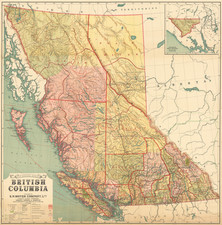
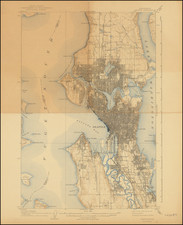
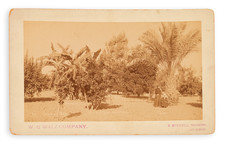
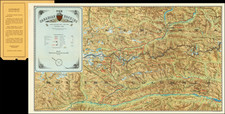
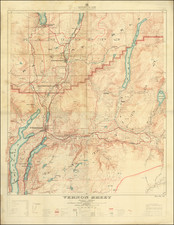
![[Victoria, B.C.] Vancouver Island -- Victoria Harbour Surveyed By Captn. G. H. Richards & The Officers of H.M.S. Plumper. 1859. The Entrance from a Survey by Lieut. B.M. Chambers. R.N. 1895. Amendments by Capt. J.F. Parry, H.M. Surveying Ship](https://storage.googleapis.com/raremaps/img/small/69236.jpg)